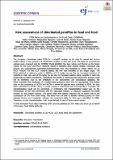Por favor, use este identificador para citar o enlazar a este item:
http://hdl.handle.net/10261/204388COMPARTIR / EXPORTAR:
 SHARE SHARE
 CORE
BASE CORE
BASE
|
|
| Visualizar otros formatos: MARC | Dublin Core | RDF | ORE | MODS | METS | DIDL | DATACITE | |

| Título: | Risk assessment of chlorinated paraffins in feed and food |
Autor: | Schrenk, Dieter; Bignami, Margherita; Bodin, Laurent; Chipman, James Kevin; Del Mazo, Jesús CSIC ORCID ; Grasl-Kraupp, Bettina; Hogstrand, Christer; Hoogenboom, Laurentius (Ron); Leblanc, Jean-Charles; Nebbia, Carlo Stefano; Ntzani, Evangelia; Petersen, Annette; Sand, Salomon; Schwerdtle, Tanja; Vleminckx, Christiane; Wallace, Heather; Brüschweiler, Beat; Leonards, Pim; Rose, Martin; Binaglia, Marco; Horvath, Zsuzsanna; Bordajandi, Luisa R. CSIC; Nielsen, Elsa | Palabras clave: | Chlorinated paraffins SCCP MCCP LCCP Food Feed Risk assessment |
Fecha de publicación: | 19-dic-2019 | Editor: | John Wiley & Sons | Citación: | EFSA Journal 18(3):5991 (2020) | Resumen: | The European Commission asked EFSA for a scientific opinion on the risks for animal and human health related to the presence of chlorinated paraffins in feed and food. The data for experimental animals were reviewed and the CONTAM Panel identified the liver, kidney and thyroid as the target organs for the SCCP and MCCP mixtures tested in repeated dose toxicity studies. Decreased pup survival and subcutaneous haematoma/haemorrhage were also identified as critical effects for an MCCP mixture. For the LCCP mixtures tested, the liver was identified as the target organ. The Panel selected as reference points a BMDL10 of 2.3 mg/kg bw per day for increased incidence of nephritis in male rats, and of 36 mg/kg bw per day for increased relative kidney weights in male and female rats for SCCPs and MCCPs, respectively. For LCCPs, a reference point relevant for humans could not be identified. Due to the limitations in the toxicokinetic and toxicological database, the Panel concluded that derivation of a health-based guidance value was not appropriate. Only limited data on the occurrence of SCCPs and MCCPs in some fish species were submitted to EFSA. No data were submitted for LCCPs. Thus, a robust exposure assessment and consequently a complete risk characterisation could not be performed. A preliminary risk characterisation based only on the consumption of fish was performed, and the calculated margins of exposure suggested no health concern for this limited scenario. The Panel noted that dietary exposure will be higher due to the contribution of CPs from other foods. The Panel was not able to identify reference points for farm animals, horses and companion animals. No occurrence data for feed were submitted to EFSA.Therefore, no risk characterisation could be performed for any of these animal species. | Descripción: | 220 p.-4 fig.-37 tab.-15 fig. compl.-16 tab. compl.-2 tab. append. | Versión del editor: | https://doi.org/10.2903/j.efsa.2020.5991 | URI: | http://hdl.handle.net/10261/204388 | DOI: | 10.2903/j.efsa.2020.5991 | E-ISSN: | 1831-4732 |
| Aparece en las colecciones: | (CIB) Artículos |
Ficheros en este ítem:
| Fichero | Descripción | Tamaño | Formato | |
|---|---|---|---|---|
| j_efsa_Schrenk_D_2020.pdf | 25,29 MB | Adobe PDF |  Visualizar/Abrir |
CORE Recommender
PubMed Central
Citations
9
checked on 16-abr-2024
SCOPUSTM
Citations
56
checked on 16-abr-2024
WEB OF SCIENCETM
Citations
36
checked on 22-feb-2024
Page view(s)
160
checked on 19-abr-2024
Download(s)
291
checked on 19-abr-2024

